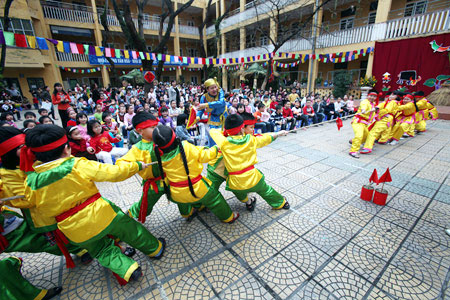Villagers across Viet Nam play various forms of tug of war (keo co). The game is always symbolically linked to the seasons, weather and crops. Tug of war is a popular game for both children and adults since it requires no particular skill or training.

However, the moment a competition begins, the viewers' noisy acclaim inspires the participants, increasing their zest to win.
Players divide into two teams and stand face to face along a bamboo cord. A red piece of cloth marks the middle of the cord, which is above a line drawn with lime in the dirt. After a signal from the referee, players tug the cord as hard as possible to pull the red cloth towards their side. Eventually one team loses strength and let’s go of the cord; the audience cheers the other team as winners.
Tug of war has become a sport, but in many regions it still reflects traditional Vietnamese beliefs. For example, in Tich Son Village, Vinh Phuc Province, tug of war fur men only is held on the third day of the first lunar month after Tet. Organizers arrange the cord in an east-west direction, evoking the trajectory of the sun. Older men stand to the east, younger men to the west. After three matches, the team that compels the other group to take three steps forward is the winner. According to traditional belief, if the eastern (older) team wins, the villagers will have bumper crops throughout the year.
Therefore, the western team often "volunteers" to lose. Spectators cheer their favorite team from outside a circle drawn with lime. They toss into the air and pass around over their shoulders any villager-old or young-who steps over the line, whether inadvertently or from pushing.
In Huu Chap Village, Bac Ninh Province, the tug of war takes place on the fourth day of Tet. Players form two teams of unmarried boys and girls. The boys represent the duong force (yang) and the dry season, while the girls represent am (yin) and the rainy season. Although the boys are frequently stronger than the girls, the girls often "win" the tug of war so that the rainy season can outdo the dry season and the harvests that year will be plentiful. The ritual meaning of the tug of war is even clearer among the Thai ethnic minority.
Not long ago, Thai people in Con Cuong District, Nghe An Province still performed a ritual called "pulling the dragon's tail" as part of a prayer for rain. Thai people believe that drought occurs because the dragon has overslept or is trapped underground. Thus, they must extract the dragon by pulling its tail.
To this end, villagers bury rice plants and an areca branch, which represents the dragon's tail, in a 50-deep hole. Then they place a hollow section of the areca branch over a neighboring hole to serve as a drum. Since the dragon is a female, the person officiating is a woman and should be a widow as the bearer of the rice plant's soul. The moment surrounding villagers beat the drum, which symbolises thunder, the woman tugs on an areca leaf to make the rice grow. One after another, young girls come to help her, forming a long row. Finally, they liberate the areca branch from the earth for an omen of good harvest.